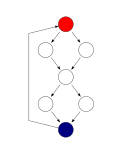Cyclomatic complexity
Cyclomatic complexity is a measurement to see how difficult a computer program is to understand. The measurement was developed by Thomas J. McCabe, Sr. in 1976. It looks at the program's source code and measures the number of independent paths through the source code. The concept is similar to the general text complexity, which is measured by the Flesch-Kincaid Readability Test.
Cyclomatic complexity is computed using the control flow graph of the program: the nodes of the graph correspond to indivisible groups of commands of a program, and a directed edge connects two nodes if the second command might be executed immediately after the first command. Cyclomatic complexity may also be applied to individual functions, modules, methods or classes within a program.
One testing strategy, called Basis path testing by McCabe who first proposed it, is to test each linearly independent path through the program; in this case, the number of test cases will equal the cyclomatic complexity of the program.[1]
Cyclomatic Complexity Media
The same function, represented using the alternative formulation where each exit point is connected back to the entry point. This graph has 10 edges, eight nodes and one connected component, which also results in a cyclomatic complexity of 3 using the alternative formulation (10 − 8 + 1 = 3).
References
- ↑ A J Sojev. "Basis Path Testing".

